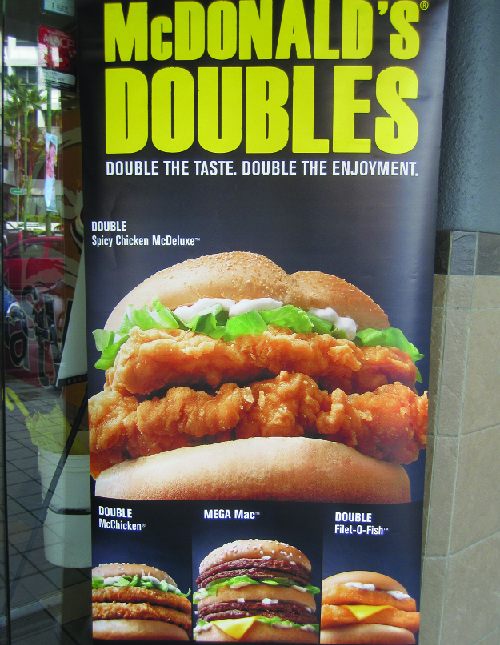Chapter 11: Ethics & Social Responsibility
11.1 Marketing Ethics
Learning Objectives
- Discuss how social media has altered the advertising landscape
- Explain the influence of advertising on consumers
Legal and Ethical Constraints on Marketing and Advertising
As the most visible form of marketing, advertising is one of the principal motors of a capitalist economy and also one of the largest modern industries: the global advertising market was projected to be at $790 billion in 2022 (the United States was the largest national market at $318 billion). Advertisements not only inform consumers of available products, services, promotions, and sales, they also serve a vital business function by allowing brands to distinguish themselves from competitors, which rewards firms for improving the quality of their offerings. Advertising is a key ally for innovation because advertising allows firms to create awareness and desire among consumers to buy new products. Despite these benefits, the advertising industry has long been suspected of using devious tactics. As a result, many consumers are highly skeptical and even disdainful of advertising in general.
Advertisers sometimes take the risk of shocking the public with their ads because they are seeking to break through the communications clutter of modern life. Today, the average person is exposed to a great number of advertising messages every day, with estimates running from several hundred to several thousand ads per day. To attract the public’s attention, advertisers may resort to appeals and tactics of questionable taste. Social critics point to advertising as one of the most objectionable aspects of our consumer economy. From the billboards that blot out the countryside along highways, to the television shows that are interrupted every few minutes by outlandish commercials, to the mailboxes and e-mail accounts that become cluttered with direct marketing, advertising methods are often criticized for being intrusive, offensive, silly, and even dishonest.

As a result of the perceived abuses of advertising, national governments all over the world have imposed laws and regulations on the advertising industry. Every country or region has its own area of sensitivity. In many Muslim nations, for example, there are prohibitions against advertisements that display nudity or offend traditional notions of decency. France and Germany prohibit comparative advertisements in which one brand claims to be superior to another.
The modern marketplace abounds with products that pose difficult challenges for regulators. Consider the example of tobacco and alcohol. These products can be harmful or dangerous, but many people nonetheless desire to consume them. Most Western countries have decided that it is counterproductive to outlaw the sale of tobacco and alcohol, as doing so may create a black market and stimulate organized crime. The official response of most governments has been to allow the sale of such products but to prohibit or strictly constrain their advertising. Other product categories that tend to be governed by specific advertising regulations include pharmaceuticals and financial products.
Another common type of marketing regulation is one that prohibits advertisements from making false, deceptive, or misleading claims. In most countries, such rules are enforced by the ministry for consumer affairs. In the United States, rules against deceptive advertisements are promulgated and enforced by the Federal Trade Commission (FTC).
There are certain product categories in which exaggerated claims are commonly made. For example, in the case of skin creams, cosmetics, perfumes, deodorants, toothpaste, mouthwash, and so on, advertisers typically claim (or suggest indirectly) that their products make the consumer more physically attractive, especially to the opposite sex. The problem is that some consumers may not be sophisticated enough to discern the difference between innocent puffery and claims of effectiveness. Thus, teenage boys have been known to douse themselves with Unilever’s Axe deodorant products in the hope that they will attract females as effectively as is suggested in Axe’s notoriously provocative advertising. Many advertisements for such products come so close to making deceptive appeals that they may garner the FTC’s attention. As a result, advertisers have learned to be cautious in the precise wording of their claims. For example, advertisements for skin cream may permissibly suggest that the user’s skin will “look and feel better” after use of the product, but they cannot include text guaranteeing the disappearance of wrinkles.

In many countries, regulators are especially vigilant when it comes to advertising aimed at children, because it is felt that children are sometimes more susceptible to manipulation or suggestion and are less likely to understand the dangers associated with the use of an advertised product. In Greece, for example, toy advertisements are prohibited between the hours of 7 a.m. and 10 p.m. In Sweden and Norway, all advertising aimed at children is prohibited, and in France, a child may not appear as the spokesperson in a commercial. In Holland, advertisements for sweets must include a toothbrush at the bottom of the ad to remind children to brush their teeth after eating sweets.
Many advertisements and marketing tactics fall into a regulatory grey area, where the advertisement is technically legal but still manages to offend some of the population. A frequent cause of such offense is the advertiser’s quest to develop a humourous or surprising advertisement. For example, one Danish advertisement featured an image of the Pope wearing a particular brand of sneakers, which offended many Catholics. In Italy, the fashion company Benetton shocked the nation by using an advertisement in which a priest is seen kissing a nun. In cases like these, it is not possible to make the advertisements illegal, but advertising industry associations feel it is necessary nonetheless to police the market for objectionable advertisements.
The Rise of Social Media
Relevant to any discussion of the influence and ethics of advertising is the emergence and dominance of social media, which now serve as the format within which many people most often encounter ads. Kelly Jensen, a digital-marketing consultant, says, “Today, using social media to create brand awareness, drive revenue, engage current customers, and attract new ones isn’t optional anymore. Now it is an absolute must.” Jensen argues convincingly that social media platforms reach many consumers, especially younger ones, who simply cannot be captured by conventional advertising schemes.
This upending of conventional modes of advertising has begun to dramatically change the content of ads. It certainly presents a new stage on which people as young as their teens increasingly rely for help in choosing what to buy. Many marketers have come to appreciate that if they are not spreading the word about their products and services via an electronic source, the younger market segments will ignore it.
Undeniably, a digital environment for advertising, selling, and delivering products and services functions as a two-edged sword for business. It provides lightning-quick access to potential customers, but it also opens pathways for sensitive corporate and consumer data to be hacked on an alarming scale. It offers astute companies nearly unlimited capacity to brand themselves positively in the minds of purchasers, but it simultaneously offers a platform for disgruntled stakeholders to assail companies for both legitimate and self-serving reasons.
Regardless of the delivery platform, however, any threat the advertising of unnecessary or harmful products may pose to our autonomy as consumers is complicated by the fact that sometimes we willingly choose to buy goods or services we may not necessarily require. Sometimes we even buy things that have been proven to be harmful to us, such as cigarettes and sugary drinks. Yet we may desire these products even if we do not need them. If we have the disposable income to make these discretionary purchases, why should we not do so, and why should advertisers not advise us of their availability?
Does Advertising Drive Us to Unnecessary Purchases?
Psychological appeals form the basis of the most successful ads. Going beyond the standard ad pitch about the product’s advantages, psychological appeals try to reach our self-esteem and persuade us that we will feel better about ourselves if we use certain products. If advertising frames the purchase of a popular toy as the act of a loving parent rather than an extravagance, for instance, consumers may buy it not because their child needs it but because it makes them feel good about what generous parents they are. This is how psychological appeals become successful, and when they do work, this often constitutes a victory for the power of psychological persuasion at the expense of ethical truthfulness.
Purchases are also affected by our notion of what constitutes a necessity versus a luxury, and that perception often differs across generations. Older consumers today can probably remember when a cell phone was considered a luxury, for instance, rather than a necessity for every schoolchild. On the other hand, many younger consumers consider the purchase of a landline unnecessary, whereas some older people still use a conventional phone as their main or even preferred means of communication. The cars and suburban homes that were once considered essential purchases for every young family are slowly becoming luxuries, replaced, for many millennials, by travel. Generational differences like these are carefully studied by advertisers who are anxious to make use of psychological appeals in their campaigns.
A consumer craze based on little more than novelty—or, at least, not on necessity or luxury in the conventional sense—is the Pet Rock, a recurring phenomenon that began in 1977. Pet Rocks have been purchased by the millions over the years, despite being nothing more than rocks. During the 2017 holiday shopping season, they retailed at $19.95. Is this a harmless fad, or a rip-off of gullible consumers who are persuaded it can satisfy a real need? In the annals of marketing, the Pet Rock craze denotes one of the most successful campaigns—still unfolding today, though in subdued fashion—in support of a dubious product.

As long as marketers refrain from breaking the law or engaging in outright lies, are they still acting ethically in undertaking influential advertising campaigns that may drive gullible consumers to purchase products with minimal usefulness? Is this simply the free market in operation? In other words, are manufacturers just supplying a product, promoting it, and then seeing whether customers respond positively to it? Or are savvy marketing campaigns exerting too much influence on consumers ill prepared to resist them? Many people have long asked exactly these questions, and we still have arrived at no clear consensus as to how to answer them. Yet it remains an obligation of each new generation of marketers to reflect on these points and, at the very least, establish their convictions about them.
A second ethical question is how we should expect reasonable people to respond to an avalanche of marketing schemes deliberately intended to separate them from their hard-earned cash. Are consumers obligated to sift through all the messages and ultimately make purchasing decisions in their own best interest? For example, does a perceived “deal” on an unhealthy food option justify the purchase (figure 11.4)? These questions have no consensus answers, but they underlie any discussion of the point at which sophisticated advertising runs headlong into people’s obligation to take responsibility for the wisdom of their purchases.

No one would argue that children are particularly susceptible to the ads commercial television constantly rains over them. Generally, young children have not developed sufficient judgment to know what advertised products are good for them and which ones have little or no benefit or perhaps can even harm. Research has even shown that very young children have difficulty separating what is real on television from what is not. This is especially so as it pertains to advertising for junk food. Savvy marketers take advantage of the fact that young children (those younger than age seven or eight years) view advertising in the same manner they do information from trustworthy adults—that is, as very credible—and so marketers hone pitches for junk food directly to these children.
What restrictions could we reasonably impose on those who gear their ads toward children? We could argue that they should take special care that ads targeting children make absolutely no exaggerated claims because children are less capable of seeing through the usual puffery that most of us ignore. Children are more literal, and once they gain the ability to understand messages directed toward them, especially when voiced by adult authority figures, they typically accept these as truthful statements.
When adults make poor consumer choices, who is responsible? Is it ourselves? Is it our society and culture, which permit the barrage of marketing to influence us in ways we often come to regret? Is it the persuasive power of marketers, and should we rein it in through law? Do adults have the right to some assistance from marketers as they attempt to carry out their responsibility to protect children from manipulative ads? We have no easy answers to these questions, though they have taken on special urgency as technology has expanded the range of advertising even to our smartphones.
Key Takeaways
Advertising, while informing consumers, has potential for being harmful to consumers and remain a regulated industry. Despite this, there are many “grey” areas in which companies publish legal, though morally questionable, ads. Social media has changed the way advertisers reach out to their customers. Further criticisms include inducing customers to purchase unneeded items and making poor financial decisions.
Review and Reflect
- Does modern society have too much advertising? How could we control it? Can you suggest any specific mechanisms or regulations that should be implemented?
- Why is self-regulation important in advertising?
Media Attributions
- Budweiser © Frank Gruber is licensed under a CC BY-NC-ND (Attribution NonCommercial NoDerivatives) license
- pexels-leonardo-luz-16488170 © Leonardo Luz is licensed under a All Rights Reserved license
- fidget-spinner-2748231_1920 © RobinHiggins is licensed under a All Rights Reserved license
- Big Burgers – Asia (5490379696) © Kinoko kokonotsu is licensed under a CC BY (Attribution) license
exaggerated claims
online communication among interdependent and interconnected networks of organizations, people, and communities
trying to reach our self-esteem and persuade us that we will feel better about ourselves if we use certain products

